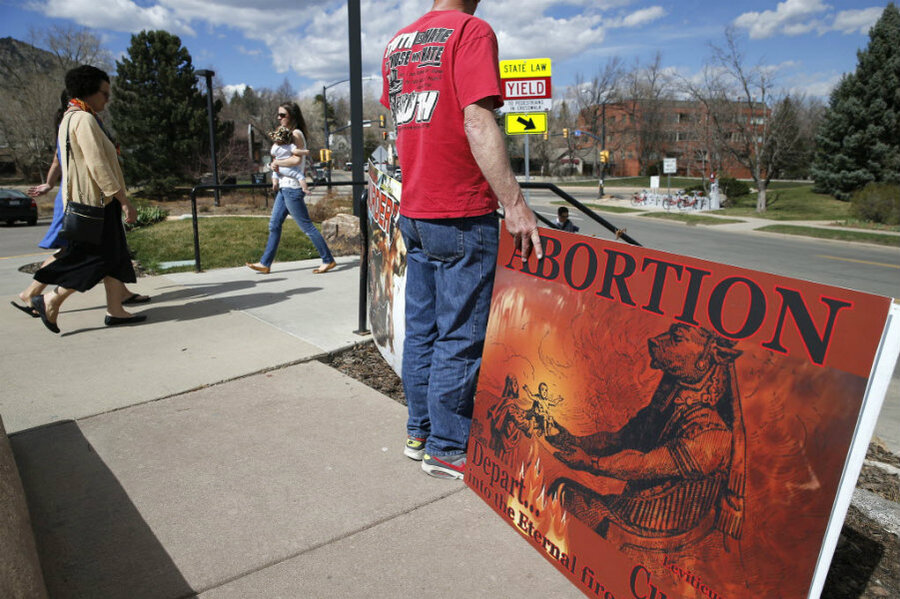What do Americans really think about abortion? The answer may surprise you.
Loading...
Abortion is one of the most polarizing issues in the United States today, but public opinion may not be as black and white as it seems.
In a Vox survey on abortion policy published earlier this month, careful questioning of more than 1,000 respondents suggests that plenty of Americans identify neither as only "pro-choice" nor as only "pro-life." On the contrary, 21 percent said they were neither, while 18 percent said they were both.
The poll’s findings unearth the nuances in public opinion often neglected when the media, politicians, and other opinion surveys frame the abortion debate as purely two-sided. The poll could also open up discussion about the issue in ways that – as Fordham University ethicist Charles Camosy put it – involves critical thinking, and takes into account the importance of precise language and constructive engagement when tackling such sensitive subjects as the life of an unborn child and a woman’s rights concerning her body.
“We’ve framed our abortion debate all wrong. It isn’t black and white – it’s thousands of different shades of gray that exist somewhere in the middle,” Vox senior editor Sarah Kliff wrote. “This matters because by ignoring that gray space, we miss something important: there are abortion policies that a majority of Americans could agree on.”
The majority of respondents, for instance, said that they would want to hear from elected officials of both genders talking about the issue. Nearly 70 percent would not want a woman to feel ashamed to admit if she had an abortion. But when asked about abortion being completely illegal or legal, and given various options in between, the largest percentage (34) chose this answer: "Abortion should only be legal in cases of rape, abuse, or if the woman’s health is at risk."
A big challenge to moving the abortion debate forward is overcoming the stereotypes that have evolved as a result of years of framing the discussion in binary terms such as "pro-life" versus "pro-choice," or "liberal" versus "conservative," according to Mr. Camosy, who teaches Christian ethics at Fordham in the Bronx and wrote, “Beyond the Abortion Wars: A Way Forward for a New Generation.”
“It is no secret that popular media have a real struggle communicating complexity,” Camosy wrote. “Thus they struggle not only to accurately describe what Americans think about abortion, but also the complex reasons many women have abortions … the reality for women is far messier and cannot be captured by a headline or Tweet.”
In other words, there’s room for discussion beyond yes or no, pro or anti. And that may be a lesson applicable to other issues, such as immigration, that appear to have divided the nation.
In an op-ed for news magazine The Week, for example, journalist Damon Linker pointed out that looking at only two sides of the immigration debate tends to lead exactly where it has gone so far: Nowhere. A viable policy, he wrote, is one that is based neither solely on moral grounds, which would give anyone who shows up at the border full citizenship, nor on the tenets of exclusivism, which would oppose the ideals of the US Constitution.
“What we're left with, then, is a position situated somewhere between the universalists and the tribalists,” Mr. Linker wrote. “We need a tightly controlled border, but with relatively liberal quotas for legal immigration, some allowances made for humanitarian refugees, and a path to citizenship for those already here. We can and should debate precisely how liberal those quotas should be, how many refugees to let in, and how arduous to make the path to citizenship.”
The path to useful policies thus lies in how we approach an issue, Camosy wrote. In the abortion debate, he added, that means avoiding using words and phrases – “radical feminist,” “war on women,” “anti-science,” or “heretic” – that lead to rhetorical victories at the cost of understanding.
Promoting meaningful discussion also requires humility and, instead of assuming the other side has a secret personal agenda, giving them the courtesy of listening to their arguments.
Such practices, Camosy wrote, “often reveals that many of us are ultimately after very similar things (such as women being able to choose to keep their baby) and we simply need to be able to talk in an open and coherent way about the best plan for getting there.”
Vox’s Ms. Kliff would agree. She wrote:
I find it rare to see leaders of the pro-life and pro-choice movements having a productive conversation. When put into debate, they often talk past each other. ... But I could easily see the people I interviewed … having a productive discussion about how our country regulates abortion.








